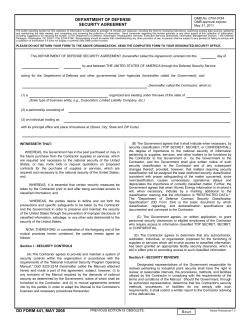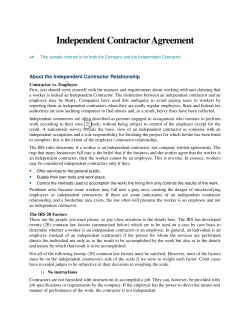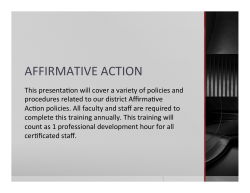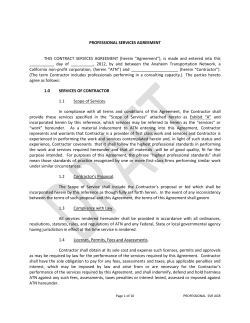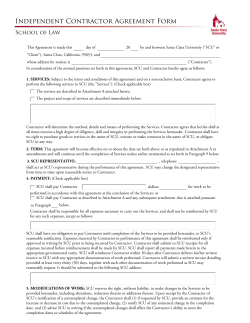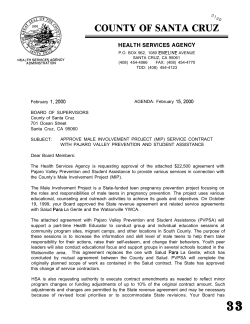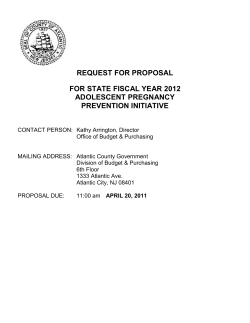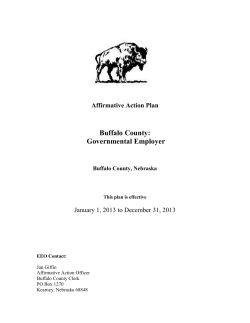
Affirmative Action/Fair Employment Practices Glossary of Terms
Affirmative Action/Fair Employment Practices Glossary of Terms Accessibility - the extent to which a contractor’s facility is readily approachable and usable by individuals with disabilities, particularly such areas as the personnel office, worksite and public areas. Administering Agency - any department, agency or establishment in the Executive branch of the Government, including any wholly-owned Government corporation, that administers a program involving federally assisted construction contracts. Administrative Complaint - the document that begins an administrative enforcement proceeding under Executive Order 11246, Section 503, or 38 U.S.C. 4212. Administrative Law Judge (ALJ) - the presiding official at administrative enforcement proceedings. Adverse Treatment - action that would in any way deprive an individual of employment or educational opportunity or negatively affect his or her status. Affected Class - those groups of persons, protected by antidiscrimination law, who because of past discrimination continue to suffer the effects of such discrimination. Affected class status must be determined by analysis or court decision. (See also protected Class.”) Affirmative Action - any action that is intended to correct effects of past discrimination, to eliminate present discrimination, or to prevent discrimination in the future. Affirmative Action Clause - the clauses set forth in 41 CFR 60-250.4 and 41 CFR 60- 741.4 that must be included in Federal contracts and subcontracts. These two clauses outline the affirmative action requirements for special disabled veterans, Vietnam era veterans and individuals with handicaps. The clauses are a part of covered contracts regardless of whether they are physically incorporated into the contract and whether the contract is written. See also definition of “Equal Opportunity Clause.” Affirmative Action Officer (AAO) - the staff member in an employing organization (business, industry or higher education) who has primary responsibility for development and maintenance of the organization’s affirmative action plan. The AAO should be responsible to the president or chief executive officer and must assure that all units comply with the terms of the affirmative action plan. Affirmative Action Plan - a written document outlining those steps to be taken to bring about affirmative action as defined above. Affirmative Recruitment - special recruitment efforts undertaken to assure that qualified minorities and women are well represented in the applicant pools for positions in which they have been excluded or substantially underutilized. Such efforts may include contacting organizations and media with known constituencies of minorities or women, and similar actions. Open job posting and advertising and “Equal Opportunity Employer” statements may be necessary in many situations simply as a matter of nondiscrimination, rather than as measures of affirmative recruitment. Anecdotal Evidence - oral or written narrative evidence. A short account of some happening usually personal. (For example, interview or written statements given to an investigator that record personal experiences of employees can be anecdotal evidence of discrimination.) Anti-nepotism Policy - a policy or practice that limits the simultaneous employment of two or more members of the same family. Applicant Flow (also called Activity Report) - the processing of records of hiring, promotion, and other employment actions for the purpose of monitoring to assure the employer’s employment practices and procedures are accomplished in accordance with the policies of the affirmative action plan. Applicant Pool - total of those persons who have applied for a particular position (or who have applications on file) from which an employee may be selected. Apprenticeship - a system of indenture or other agreement, written or implied, to train a person in a recognized trade or craft in accordance with specified standards. Availability Pool - total of those persons in the relevant work force, i.e., those persons including the protected classes, who meet the minimum qualifications for any available position. (See “Relevant Work Force,”) Back Pay - compensation for past wage and benefit losses caused by a contractor’s discriminatory employment practices or procedures. Lost wages include, e.g., overtime, incentive pay, raises, bonuses economic loss includes compensatory damages. (See also “fringe benefits.”) Bargaining Agreement - also referred to as collective bargaining agreement and sometimes known as labor-management agreement or union contract. These terms refer to an agreement between an employer and a union establishing wages, hours, and other terms and conditions of employment for employees in the bargaining units represented by the union. Bona Fide Occupational Qualification (BFOQ) - a worker may be chosen on the basis of sex, age, or religion only if sex, age, or religion is a minimum qualification required as a prerequisite for hiring and/or success for a particular job. The federal agencies and the courts have interpreted BFOQ very narrowly; as related to sex under Title VII, it may apply to a male model for clothing, or perhaps a female fitter for lingerie. For age, a bus company was allowed to maintain a maximum age for hiring drivers because it could rationally believe that eliminating its age policy would increase the risk of its passengers. Religion as a BFOQ for teaching in a religious institution would probably be lawful only for the teacher of religion. BFOQ may not be used as a defense for hiring according to stereotypes, and if challenged the employer must demonstrate the validity of the BFOQ in question. BFOQs are seldom allowed for race or national origin. Bona Fide Seniority System - a seniority system that was not created and is not maintained for the purpose of discriminating on the basis of a prohibited factor. Bumping Rights - rights of an employee to displace another employee due to a layoff or other employment action as defined in a collective bargaining agreement or other binding agreement. Burden of Proof - the requirement that to win a point or to have an issue decided in one’s favor in a lawsuit one must show that the weight of the evidence is on his or her side, rather than “in the balance” on that question. Philosophically and traditionally, in the courts the person who brings the charges is responsible for providing evidence to support those charges. In civil rights litigation, the courts have generally required the plaintiff to establish a prima facie case of discrimination, at which point the burden of proof shifts to the defendant (e.g., the employer) to justify the existence of any disparities. Once the plaintiff has made the prima facie case, the defendant must provide an explanation since he or she is in a position to know whether he or she failed to hire a person for reasons that would exonerate him or her. Business Necessity - ruled by the Supreme Court as the “touchstone” for determining the lawfulness under Title VII of discriminatory effect. Federal court decisions indicate that, in order to be justified by business necessity, a practice must be essential to the safe and efficient operation of a business. As applied, this rule generally involves the question of whether an employer would be committed to additional costs or safety hazard if the discriminatory practice were abandoned. Savings to be gained in shorter time necessary for training employees on new jobs, preserving or bettering a company’s image, customer or co-worker preferences, superior or inferior ability to perform nonessential aspects of a job, or need to maintain harmony or decorum at a place of business do not qualify as business necessities and will not justify discriminatory practices. Career Ladder - the jobs that require related and increasingly more responsible duties through which employees advance by experience and in-service training gained in the lower jobs. In affirmative action programming, there should be as many career-ladder opportunities, with comparable salary ranges, for women and minorities as for white male employees. Civilian Labor Force - the aggregate of the persons classified as employed and as unemployed in accordance with the criteria established by the Bureau of the Census and the U.S. Department of Commerce. (See Employed and Unemployed). Class Action - a lawsuit brought for oneself and all other persons in the same situation. In civil rights, related actions may be brought on behalf of all past, present, or future persons of the same charging class and at all locations within the US of any specific defendant. Certain specific conditions found in Rule 23(B) of the Federal Rules of Procedure must be met for a class action suit to be brought. In another sense, particularly in civil rights law, “class action” can be the legal effect of a court decision based on alleged characteristics of a certain class of persons in a particular situation. Collateral Estoppel - a bar to relitigating an issue that has already been litigated between the same parties or certain closely related persons (sometimes know as privies). Under collateral estoppel, when an issue has been contested and finally resolved in litigation involving the parties, that resolution of the issue is binding on future litigation involving the two parties (or their privies). Commissioner’s Charge - refers to a discrimination charge brought in the public interest by an EEOC commissioner against an employer, labor organization, or employment agency, on behalf of an affected class. In such a charge, there need be no named charging parties who allege personal injury by the discriminatory acts alleged. Comparable Worth - the principle that jobs can be compared which may be dissimilar in nature but equal or equivalent in terms of skill, effort, responsibility and working conditions. Comparative Evidence – nonstatistical evidence that compares the contractor’s treatment of individuals of one group (e.g., race) with its treatment of similarly situated individuals of other groups. Also see “Statistical Evidence” and “Anecdotal Evidence.” Complaint - a written charge filed with OFCCP by an employee, former employee, applicant for employment or by a third party alleging specific violations of the Executive Order, Section 503 or 38 U.S.C §4212 Complainant or Charging Party - a person who brings a complaint; in equal opportunity/affirmative action related actions, a person who brings a complaint of discrimination. Compliance - within the limits of the nondiscrimination laws and their interpretations by the courts. An organization can, through self-analysis and official changes, remove its exposure to class action suits through complying with all Civil Rights Legislation, and individual cases of discrimination can be avoided through training and awareness sessions with managers, supervisors, and other employees in the personnel process. Full compliance requires both. Compliance Agency - an agency that conducts routine reviews of employers’ compliance with federal employment discrimination laws and regulations. (See “OFCCP.”) Other agencies investigate complaints of individual workers. (See, for example, “Equal Employment Opportunity Commission.”) Compliance Review - a routine review of the employment practices of a contractor by OFCCP or its designee for compliance with Executive Order 11246. Conciliation - an informal voluntary agreement between an employer and a complainant sought by a state or local agency or the EEOC. A successful conciliation can result in back pay awards, reinstatement, and reform in the employment practices of an employer. A failed conciliation does not preclude further legal action by a complainant or an agency. Conciliation Agreement (CA) - a binding written agreement between a contractor and OFCCP that details specific contractor commitments to resolve the alleged violations set forth in the agreement. Constructive Discharge - an employee’s involuntary resignation resulting from the employer making working conditions for the employee so intolerable that a reasonable person would have felt compelled to resign. OFCCP will assert that an employee was constructively discharged in violation of the Executive Order, Section 503, or 38 U.S.C. §4212 where it finds that (1) a reasonable person in the employee’s position would have found the working conditions intolerable; (2) the employer’s conduct which constituted the violation against the employee created the intolerable working conditions; and (3) the employee’s involuntary resignation resulted from the intolerable working conditions. Continuing Violation - the continuing violation theory has been analyzed as encompassing three separate sub-theories, each applicable to distinct fact situations: (1) a series of individual related discriminatory acts, at least one of which must have occurred within 2 years prior to the notice of a compliance review, or 180 days before the filing of a complaint of employment discrimination; (2) systemic discrimination where the employer has maintained a policy or practice which discriminates against a class of individuals; and, (3) present effects of past discrimination— where an individual or a class is suffering the residual effects of discriminatory conduct which occurred prior to the limitation period but was not the subject of a timely charge. (In recent years, OFCCP has not applied the present effects of past discrimination theory.) Contract Cancellation - the termination of a Federal contract before its expiration date. Contract cancellation is one of the sanctions authorized, in appropriate cases, for violation of the Executive Order, Section 503, or 38 U.S.C. §4212. Compare “Debarment ;”“Contract Suspension.” Contract Suspension - the temporary interruption of a Federal contract by order of the appropriate authorities. Contract suspension is one of the sanctions authorized, in appropriate cases, for violation of the Executive Order, Section 503 or 38 U.S.C. §4212. Compare “Contract Cancellation;” “Debarment.” Contracting Agency - for purposes of the Executive Order, Section 503 and 38 U.S.C. §4212, a contracting agency is any department, agency, establishment or instrumentality of the United States (under the Executive Order, limited to the executive branch of the Government), including any wholly owned Government corporation, which enters into contracts. Contractor - a contractor as described below, is: (a) Prime contractor. Any person holding, and for enforcement purposes any person who has held, a contract subject to the Executive Order, Section 503 or 38 U.S.C. §4212. (b) Subcontractor. Any person holding, and for enforcement purposes any person who has held, a subcontract subject to the Executive Order, Section 503 or 38 U.S.C. §4212. See definition of “Subcontract.” c) First-tier subcontractor. A subcontractor holding a subcontract with a prime contractor. Contracts/Grants - money awarded by the federal government and subject to various equal opportunity/affirmative action requirements. Contracts are goods and services provided by a contractor and are covered, for example, by Executive Order 11246. Grants are sums of money awarded for research or other purposes. Grants are also included under provision of Title IX, Section 504 (see below), and other regulations. Student loans have been defined by HEW’s Office for Civil Rights as “grants.” Deadend Job - a position for which promotion opportunities are slim or nonexistent. Debarment - an order declaring a contractor ineligible for the award of future contracts. Debarment is one of the sanctions that may be imposed upon a contractor who is found to be in violation of the Executive Order, Section 503, or 38 U.S.C. §4212. Deferral and Deferral Agency - under Title VII as amended, Section 706, an EEOC 706 state or local agency (for example, State Human Rights or Civil Rights Commission) routinely is given 60 days to resolve any discrimination complaint filed with EEOC within a geographical area where 706 state agency is recognized. At the end of 60 days, the state agency may request a time extension if the complaint is progressing well. When the EEOC assumes responsibility for a complaint that has previously been investigated by a 706 state or local agency, that agency’s findings are given great weight by EEOC. Local agencies not officially recognized as 706 agencies also hold the status of a “deferral agency” for a 60-day period. Deficiency - failure to fulfill a requirement of the Executive Order; Section 503 or 38 U.S.C. §4212, including implementing rules, regulations and orders. See “Violation.” (The terms deficiency and violation often are used interchangeably.) Department Seniority - a system under which the privileges obtained by an employee as a result of number of years of service are applied only in the department where the employee works and not plant or institution wide; a transferred employee must start anew to build seniority for privileges rather than carry years of service to the new position in a different department. Departmental seniority systems have been sometimes charged to be discriminatory when a particular class of persons is sustained only in a particular department. Deposition - a type of pre-trial discovery. (See “Discovery.”) An oral deposition is the examination, under oath, by the lawyer for one party of a person (such as a potential witness for the party) who is believed to have knowledge of facts or circumstances relevant to the matter in litigation. A transcript of the examination is made and can be used at trial for some purposes. Director - the Director of the Office of Federal Contract Compliance Programs of the United States Department of Labor. Direct Evidence of Discrimination - a method of proof in which evidence on its face establishes a discriminatory reason for an employment decision, with inference or presumption. Direct evidence is evidence that on its face shows an intent to discriminate. It may be based upon testimony or any reliable documentation such as a copy of a help wanted ad that specifies “males only.” Disabled Veteran - See “Special Disabled Veteran.” Discovery - in trial practice, the pre-trial devices that can be used by a party to obtain facts and information about the case from the other party in order to assist the party’s preparation for trial. Tools of discovery include: depositions upon oral and written questions, written interrogatories, requests for production of documents or things, requests for physical and mental examinations, and requests for admission. (See “Deposition.”) Discrimination - the failure to treat equals equally; in equal opportunity/affirmative action parlance, the unequal treatment categorizing is based on race, sex, religion, national origin, marital status, Vietnam veteran status, ex-offender status, or physical or mental disability or has the effect of disparate treatment for any of those classes. Unlawful discrimination may be either intentional or not intentional. Disparate Effect (or Disparate Treatment) - disproportionate exclusion or denial of opportunities for a particular class or class(es) by past or present policies and practices whether intentional or not. A disparate impact may be revealed by means of statistical analysis of a particular work force. Disparate Impact - a theory or category of employment discrimination. Disparate impact discrimination may be found when a contractor’s use of a facially neutral selection standard (e.g., a test, an interview, a degree requirement) disqualifies members of a particular race or gender group at a significantly higher rate than others and is not justified by business necessity or job relatedness. An intent to discriminate is not necessary to this type of employment discrimination. The disparate impact theory may be used to analyze both objective and subjective selection standards. Due Process Cause - Fourteenth Amendment to the US Constitution guarantees that no person shall be deprived of life, liberty, or property without due process of law. The due process requirements, regularly changed by the US Supreme Court action, vary in detail, but essentially a person should always have notice and a valid chance to present his or her side in a legal dispute, and no law or government procedure should be arbitrary or unfair. Employed - under criteria established by the Bureau of the Census and the U.S. Department of Commerce, all civilians 16 years old and over who were either: (a) “at work,” meaning those who did any work at all during the reference week as paid employees or in their business or profession, or on their farm, or who worked 15 hours or more as unpaid workers on a family farm or in a family business; or (b) “with a job but not at work,” meaning those who did not work during the reference week but had jobs or businesses from which they were temporarily absent due to illness, bad weather, industrial dispute, vacation, or other personal reasons. Generally excluded from the category of employed are persons whose only activity consisted of unpaid work around the house or volunteer work for religious, charitable, and similar organizations, or persons on layoff. Employee - a person employed by a Federal contractor, subcontractor or Federally assisted construction contractor or subcontractor. Employment Agency - any entity regularly undertaking with or without compensation to procure permanent employees for an employer or to procure for individuals opportunities to permanently work for an employer. Also includes an agent of such a person or entity. Employment at Will - the traditional common law doctrine that, absent prior agreement to the contrary, an employer may discharge an employee anytime for any reason except for illegal reasons, e.g. an employer’s exercise of this power may be restricted by collective bargaining or other agreement or by specific statutes, including those prohibiting discrimination on the basis of race, sex, or other factors. In some states, courts have imposed additional limits on employment at will by allowing claims for “wrongful discharge” in certain circumstances. Employment Offer - an employer’s offer to an individual of employment in a specific job. Employer Identification Number (EIN) - a nine digit number assigned to a company by the Internal Revenue Service for tax and other identification purposes. Enforcement - administrative or judicial action to compel compliance with Executive Order 11246, Section 503 or 38 U.S.C. §4212 and their implementing regulations. Equal - substantially similar. Equal Employment Opportunity (EEO) - a system of employment practices under which individuals are not excluded from any participation, advancement, or benefits because of their race, color, religion, sex, national origin, or other factor that cannot lawfully be the basis for employment action. An employment system in which neither intentional nor unintentional discrimination operates. EEO Counselor - the person within a federal agency who is responsible for dealing informally with discrimination complaints within the agency and attempts to reach internal grievance conciliation for internal complaints. Equal Employment Opportunity Commission (EEOC) - independent federal agency created by the 1964 Civil Rights Act, Title VII. EEOC may bring suit, subpoena witnesses, issue guidelines which have the force of law, render decisions, provide technical assistance to employers, provide legal assistance to complainants (and others). The EEOC, which does not conduct routine compliance reviews (see OFCCP), investigates complaints of discrimination in employment, and finding probable cause, attempts to achieve conciliation agreements and may bring failed conciliation to court of law. Equal Opportunity Clause - the sub-paragraphs contained in 41 CFR 60-1.4(a) or (b) required by Sections 202 and 301 of Executive Order 11246, as amended, to be part of contracts covered by the Executive Order, pursuant to 41 CFR 60-1.4(e) and 60-4.9, the clause is a part of covered contracts regardless of whether it is physically incorporated into the contract or whether the contract between the agency and the contractor is written. (See also definition of “Affirmative Action Clause.”) Equal Pay (as defined by the Equal Pay Act) - for equal pay purposes, equal work is defined as jobs that require equal skill, effort, and responsibility and are performed under similar working conditions. Equal Protection of Laws - Fourteenth Amendment to the US Constitution requirement that the government shall not fail to treat equals equally, set up illegal categories to justify treating persons unfairly, or give unfair or unequal treatment to a person based on such things as a person’s race or religion. The Supreme Court has only rarely applied this constitutional guarantee in matters regarding different treatments on the basis of sex and then in a very narrow sense. Establishment - a facility or unit which produces goods or services, such as a factory, office, store, or mine. In most instances, the unit is a physically separate facility at a single location. In appropriate circumstances, OFCCP may consider as an establishment several facilities located at two or more sites when the facilities are in the same labor market or recruiting area. The determination as to whether it is appropriate to group facilities as a single establishment will be made by OFCCP on a case-by-case basis. Ethnic Categories - (Federal definitions now in use) Value Description American Indian or Alaska Native A person having origins in any of the original peoples of North and South America (including Central America), and who maintains tribal affiliation or community attachment. Asian A person having origins in any of the original peoples of the Far East, Southeast Asia, or the Indian subcontinent including, for example, Cambodia, China, India, Japan, Korea, Malaysia, Pakistan, the Philippine Islands, Thailand, and Vietnam. Black or African American A person having origins in any of the black racial groups of Africa. Terms such as "Haitian" or "Negro" can be used in addition to "Black or African American." Hispanic or Latino (White race A person of Cuban, Mexican, Puerto Rican, Cuban, South or only) Central American, or other Spanish culture or origin, of white race only. Hispanic or Latino (All other races) A person of Cuban, Mexican, Puerto Rican, Cuban, South or Central American, or other Spanish culture or origin, of any race other than white. Native Hawaiian or Other Pacific Islander A person having origins in any of the original peoples of Hawaii, Guam, Samoa, or other Pacific Islands. (The term "Native Hawaiian" does not include individuals who are native to the State of Hawaii by virtue of being born there.) In addition to Native Hawaiians, Guamanians, and Samoans, this category would include the following Pacific Islander groups reported in the 1990 census: Carolinian, Fijian, Kosraean, Melanesian, Micronesian, Northern Mariana Islander, Palauan, Papua New Guinean, Ponapean (Pohnpelan), Polynesian, Solomon Islander, Tahitian, Tarawa Islander, Tokelauan, Tongan, Trukese (Chuukese), and Yapese. White A person having origins in any of the original peoples of Europe, the Middle East, or North Africa. Executive Order - a presidential or gubernatorial order having the force of law that sets forth a policy and/or directs the means to implement policy. Exempt Employees - employees that are not covered by minimum wage and overtime provisions of the Fair Labor Standard Act (Wage and Hour Law). Generally employees in the managerial ranks. Expert Witness - a person such as a doctor or statistician selected by the court or a party on account of his/her knowledge or skill, to examine, estimate, and ascertain things and make a report (testimony) of his/her findings and opinions. Facially Neutral Selection Standard/Criteria - a criterion/process is facially neutral if it does not make any reference to a prohibited factor and is equally applicable to everyone regardless of race, gender or ethnicity, i.e., is not discriminatory on its face. See also “uniformly applied.” Federally Involved Construction Contract - any Federal construction contract or subcontract, Federally assisted construction contract or subcontract, or any other construction contract, or subcontract that is necessary, in whole or in part, to the performance of a Federal supply and service contract or subcontract. Fifteen (15) Day Notice - see “Notice of Alleged Noncompliance.” First-tier Subcontractor - a subcontractor holding a subcontract with a prime contractor. Focus Job Area - a unit of an establishment’s work force (such as a seniority unit, department, line of progression, or job title, as appropriate) identified at desk audit as a potential problem area for further investigation onsite. Example: a unit where minorities or women are concentrated, underrepresented, or restricted from working because of their race or sex. Formal Training - a structured program to develop an individual’s job related skills and abilities. Typically classroom training as well as on-the-job training fall into this category. Fringe Benefits - compensation for employment other than wages or salary, including, for example, annual and sick leave, medical insurance, life insurance, retirement benefits, profit sharing, bonus plans, etc. Front Pay - compensation for estimated future economic loss; generally calculated based on the difference between the discrimination victim’s current pay (or for a rejected applicant, the pay he/she should have received) and the pay associated with his/her rightful place. Front pay runs from the time of the settlement (e.g., Conciliation Agreement), hearing, or administrative or court order to a certain time in the future set by the settlement, hearing or administrative or court order (usually when the victim attains his/her rightful place) set by the settlement, hearing or court order. (See also “Rightful Place.”) Goals - good faith quantitative objectives that an employer voluntarily sets as the minimum progress he or she can make within a certain time period through all-out efforts at outreach recruitment, validating selection criteria, creation of trainee positions, career ladders, etc. Goals and objectives are considered by EEOC, OFCCP, USCSC, DOL to be proper and legal responses to underutilization. Goals with timetables, (an established time frame) are routinely required of federal contractors by Executive Order 11246. Goals - in affirmative action plans for minorities and women within a system - are not to be confused with “quotas” designed to keep people out of a system. “Quotas” for bringing women and/or minorities into an employer’s work force in sufficient numbers to achieve equity with their numbers in the relevant work force can be ordered by the courts (or by certain compliance agencies in a voluntary agreement) where proof exists of a pattern and practice of past and continuing discrimination. (See “quota.”) Goals for Construction Contractors - in the construction industry benchmark, employment levels for minorities and women expressed as a percentage of the hours worked by the contractor’s aggregate work force by trade in a geographic area. Good Cause A. A legally acceptable defense (usually put forward by a contractor against whom OFCCP has alleged a violation of its regulations) for not having taken an action that would otherwise be required. B. Justification provided by a complainant, and found acceptable by OFCCP, as the basis for accepting an otherwise untimely complaint filing. Good Faith Efforts - this term refers to a contractor’s efforts to make all aspects of its affirmative action plan work. Designing and implementing an effective affirmative action plan requires sustained attention. The contractor must analyze its employment and recruitment practices as they affect equal opportunity, identify problem areas, design and implement measures to address the problems, and monitor the effectiveness of its program, making adjustments as circumstances warrant. In evaluating the contractor’s good faith efforts, the EOS must make a careful assessment of the quality and thoroughness of the contractor’s work to implement its program and assure equal opportunity. The basic components of good faith efforts are (1) outreach and recruitment measures to broaden candidate pools from which selection decisions are made to include minorities and women and (2) systematic efforts to assure that selections thereafter are made without regard to race, sex, or other prohibited factors. Government - except where otherwise indicated, government means the government of the United States of America. Government Contract - any agreement or modification thereof between any contracting agency and any person for the furnishing of supplies or services, or for the use of real or personal property, including lease arrangements. The term “services,” as used here, includes, but is not limited to, the following utility, construction, transportation, research, insurance, and fund depository regardless of whether the Government is the purchaser or seller. The term “Government Contract” does not include (a) agreements in which the parties stand in the relationship of employer and employee and (b) Federally assisted construction contracts. Grants - (See “Contracts.”) Grievance Procedures - in-house resolution of employees’ and/or students’ complaints, required under Title IX regulations for students and under several other federal regulations for employees. Usually includes a series of “steps” in the process. Collective bargaining agreements also usually include grievance procedures for resolving employee relations problems. Guidelines - rules issued by various agencies for compliance with a law. The guidelines are not law, but are an agency’s attempts to create rules for enforcement that carry out the intent of Congress (or of an executive order) and are within the parameters of its legal foundation as established through agency and court decisions. The term “regulations” or “regs” is frequently used to be synonymous with guidelines. Immediate Labor Area - the geographic area from which employees reasonably may commute to the contractor’s establishment. It may include one or more contiguous cities, counties, Metropolitan Statistical Areas (MSAs) or parts thereof. Impact Ratio Analysis - the Impact Ratio Analysis (IRA) is a comparison of the selection rates of different groups from an identified candidate pool. If the selection rate for one group is less than 80% of that for another, the IRA is considered adverse. Individual With a Disability - see “Individual with Handicaps.” Individual with Handicaps - any person who: (a) has a physical or mental impairment which substantially limits one or more of such person’s major life activities; (b)has a record of such an impairment; or (c)is regarded as having such an impairment. This definition does not include an individual currently engaging in the illegal use of drugs, when the contractor acts on the basis of such use. This definition does not include an individual who is an alcoholic whose current abuse of alcohol prevents such individual from performing the duties of the job in question, or whose employment, by reason of such current alcohol abuse, would constitute a direct threat to property or safety of others. The term “individual with handicaps” is used interchangeably with “individual with a disability” and “handicapped individual.” Injunctive Relief - a court order requiring a person to perform, or to refrain from performing, a designated act. For example, in an enforcement action OFCCP might seek the injunctive relief of requiring that the contractor cease asking discriminatory questions on its job application. Integrated Postsecondary Education Data System Survey (IPEDS) - data collected biennially by the National Center for Education Statistics to obtain and report a comprehensive picture of staff in institutions of postsecondary education by their full-time or part-time status and by the type of work they do. Internal Review Procedure - an internal procedure of contractors capable of resolving discrimination complaints. By regulation OFCCP allows contractors 60 days to attempt to resolve internally a complaint of employment discrimination made by an employee who is an individual with handicaps, a special disabled veteran or a veteran of the Vietnam era. Invitation to Self Identify - an invitation by the contractor, extended to employees and applicants for employment, to identify themselves as individuals with handicaps or special disabled or Vietnam era veterans for purposes of Section 503 or 38 U.S.C., §4212 in order to permit the contractor to make reasonable accommodation and take affirmative action on their behalf. All information obtained in response to such an invitation shall be kept confidential. Job Area - any subunit of a workforce sector, such as department, job group, job title, etc. Job Area Acceptance Range (JAAR) - the JAAR is an analytical tool used to analyze the distribution of employees in a workforce by comparing the actual percentage of minorities/women in a job area to their percentage in the relevant larger segment of the contractor’s workforce. Job Description - a written statement detailing the duties of a particular job title. Job Group - one or a group of jobs having similar content, wage rates and opportunities. Job-Related Qualification - the qualifications required of a person for a particular position must be related to the job or task to be accomplished by an employee. The concept that qualifications must directly relate to the position has been consistently upheld in the courts, making suspect any qualification that may be unrelated as a ruse for discrimination or at the least having the effect of discriminating against any class of persons of a particular sex or minority classification that is less likely than the majority group to have the particular superfluous qualification. Job Specification - the minimum qualification(s) the contractor identifies as necessary to perform a job. Journey Worker - one who has completed an apprenticeship or otherwise possesses the full skills and licenses of workers in his/her trade. Labor Area - geographic area used in calculating availability. The area may vary from local to nationwide. Layoff - the process by which workers are removed from the active payroll to the inactive payroll during a reduction-in-force (RIF). Life Activities (Major Life Activities) - for purposes of Section 503, this term means functions such as caring for oneself, performing manual tasks, walking, seeing, hearing, speaking, breathing, learning, and working. Line of Progression - a series of related jobs in a promotional sequence generally starting with less difficult, lower paying jobs and progressing to more difficult, higher paying jobs. Often, the lower jobs provide required training for movement to the higher level jobs. Major Life Activities - see “Life Activities.” Make Whole Relief - remedies for discrimination that restore the victim of discrimination to his or her rightful place, i.e., the position, both economically and in terms of employment Status that he/she would have occupied had the discrimination never taken place. Common elements of make whole relief include an award of the position the individual was wrongfully denied, back pay with interest, and retroactive seniority. Mandatory Job listing (MJL) - the provision of the affirmative action clause that requires covered employers to list suitable job openings with the local office of the State Employment Service. Maternity Leave - childbirth-related absence from work by a woman that does not directly depend on her medical condition. The term includes leave for nondisability related care and nurturing following the birth of a child. Distinguish from “pregnancy disability leave.” Minorities - men and women of those minority groups for whom Federal reporting is required; i.e., Black, Hispanic, Asian or Pacific Islander, American Indian or Alaskan Native. The term may mean these groups in the aggregate or an individual group. Monitoring (“watchdogging”) - checking on the performance and procedures of an institution or agency to determine compliance with, or enforcement of, the law. Nepotism - the practice of showing favoritism to relatives or close friends of other employees over other applicants applying for positions. Nepotism has been found discriminatory to minorities because the system in crafts/apprenticeships resulted in keeping minorities out of the work force. On the other hand, antinepotism rules - i.e., refusing to hire two members of the same family, may also result in discrimination. New Hire - a worker added to an establishment’s payroll for the first time. Compare with “Rehire.” Noncompliance - a contractor’s failure to adhere to the conditions set out in the contract’s equal opportunity and/or affirmative action clauses and/or the regulations implementing those clauses and/or failure to correct violations. Nonexempt Employees - employees that are covered by minimum wage and overtime provisions of the Fair Labor Standard Act (Wage and Hour Law). Normal Business Hours - for purposes of access to a contractor’s premises, the hours during which employees to be interviewed are at work, regardless of the time of day or night. Also used to indicate the regular business hours during which Section 503 and 38 U.S.C. §4212 AAPs are available for inspection by employees and applicants for employment. Notice of Alleged Noncompliance (15 Day Notice) - a letter from OFCCP to a contractor informing it that the agency believes the contractor has violated the terms of a Conciliation Agreement and that enforcement proceedings may be initiated unless the contractor demonstrates within 15 working days from its receipt of the letter that it has not violated its commitments under the Agreement. Notice of Violation (NOV) - a letter from OFCCP notifying the contractor that the agency has found violations of the Executive Order, Section 503 and/or 38 U.S.C. §4212 during a compliance review, and the remedies that are required to resolve those violations. Objective Criteria/Procedures - a criterion is objective if it is fixed and measurable. The central characteristic of an objective criterion is that it can be independently verified; i.e., different people measuring objective criteria will reach the same results. Compare with “Subjective Criteria/Procedures.” Objectives - similar to quantitative goals. Employers attempt a good faith effort to meet goals through modifications in the employment procedures and practices which are embodied in affirmative action plans. (See “Goals.”) On-the-Job Training (OJT) - an employer sanctioned training program, usually at the employer’s worksite, conducted either under close supervision or with assistance, and designed to teach and qualify an individual to perform a job or element(s) of a job. Order - generally, a short-hand term meaning Executive Order 11246, as amended. The term also is used in phrases dealing with decisions in litigation matters, such as, Final Decision and Order or Court Order. Organizational Unit - a department, division, branch, section or other organizational entity of a contractor that operates as a single unit under a common head. Overt Discrimination - open and clear discrimination; in law, more than preparation To discriminate, but the first steps taken to discriminate. Parental Leave - absence from work by a parent to care for a child. Parity - equality the ultimate goal of affirmative action programming is to achieve “parity” in a work force, i.e., women and minorities to be represented in every job category of a work force in the same proportion they are available in the total work force. Pattern or Practice Discrimination - repeated acts of discrimination resulting from formal or informal practices in employment, education (or other situations) that are derived from a broad context of social behavior that promotes discrimination. Pay Equity - the goal of fair wage-setting process which eliminates sex and race discrimination. Person - as defined in OFCCP’s regulations, “person” means any natural person, corporation, partnership, unincorporated association, state or local government, and any agency, instrumentality or subdivision of such a government. Physical & Mental Job Qualification Requirements - physical and mental standards that an employer requires a person performing or applying for a job to meet. Placement - often used in the context of the selection or assignment of individuals in a particular job. Plant-Wide Seniority - the privilege obtained by an employee resulting from a number of years of longevity in a job may be carried intact upon transfer from one department to another department of the same plant. (See “Departmental Seniority.”) Preaward Review - a compliance review required by OFCCP prior to the award of any federal contract of $1,000,000 or more. Pre-employment Medical Examination - an evaluation of the health status of an applicant for employment. Predetermination Notice - a letter in which OFCCP notifies the contractor of its preliminary finding that the contractor has engaged in a pattern or practice of discrimination. The Notice states the basis for the preliminary findings and offers the contractor the opportunity to respond. Preferential Treatment - to give an edge to one class of workers or applicant. Most often used today as relates to affirmative action efforts to bring about parity by including women and minorities in the work force, or in professional schools. Title VII does not require preferential treatment, but it can be ordered under Section 503. Preferential treatment in the form of special recruitment efforts for minorities and women is required of government contractors for positions in which they have been “underutilized.” Pregnancy-Disability Leave - pregnancy and childbirth-related absence from work by a woman affected by pregnancy, childbirth or related medical conditions. It includes leave prior to childbirth when medically indicated and leave to recover from pregnancy, childbirth or related medical conditions following the birth of a child. Prima Facie - the elements necessary to support the claim have been presented and unless evidence can be presented to rebut the previous arguments, the claim will be supported. In the EEO area, statistics for underutilization have been sufficient to make a prima facie case for discrimination; then it is the responsibility of the employer to justify the disparity as based on non-discriminatory factors, BFOQs, etc. (See “Burden of Proof.”) Problem Areas - aspects of the contractor’s employment decisions, policies, or practices that appear to raise questions regarding the contractor’s compliance with Executive Order, Section 503 or 38 U.S.C. §4212. Progression Line Charts - written listings of a contractor’s line of progression. See “Line of Progression.” Prohibited Factor - a factor prohibited by law from being used in making employment decisions. Under Executive Order 11246, as amended, the prohibited factors are race, color, religion, sex and national origin. Under Section 503, the prohibited factor is handicap; under 38 U.S.C. §42 12, it is status as a special disabled or Vietnam era veteran. Promotable Minorities and Women - Minorities and women who are qualified and eligible for promotion based upon valid selection criteria. Promotable or Transferrable - in the context of developing data for availability, those employees who are currently employed in a job group or groups that serve or could serve as a source from which selections are or could be made for other job groups. Promotion - any personnel action resulting in movement to a position affording higher pay and/or greater rank, and/or requiring greater skill or responsibility, or the opportunity to attain such. Proof of Discrimination - “Proofs” of discrimination are the factual formulations which show that discrimination under a particular theory exists. These formulations describe the kinds of facts needed to show a nexus between a particular adverse action or result and a particular prohibited factor. Proof requires evidence; see “Anecdotal Evidence,” “Comparative Evidence,” and “Statistical Evidence.” Protected Class - legally identified groups that are specifically protected by statute against employment discrimination. Unlike “affected class,” which must be demonstrated, protected class status is automatically conferred upon recognized minority group members, females, etc., by virtue of the law or other court decisions interpreting the law. (See “Affected Class.”) Protective Laws - laws passed to protect women and children from being exploited by employers who require long hours of labor in harmful work environments. But work restrictive “protection” laws based on sex were made illegal by Title ‘ill of the 1964 Civil Rights Act. Probable Cause - a reasonable suspicion, supported by facts, that a law has been violated. Qualified Special Disabled Veteran - a special disabled veteran (see below) who is capable of performing a particular job with or without a reasonable accommodation to his or her disability. Qualified Individual with a Handicap(s) - an individual with handicaps (see above) who is capable of performing a particular job, with or without reasonable accommodation to his or her handicap. Quota - a term that describes the practice whereby a certain number of people of a certain class must be included or limits placed on the number of people who may be admitted. For example, until World War 11, Jews admitted to professional schools were kept within certain spoken or unspoken quotas; more recently the numbers of women admitted to professional and other schools were limited to certain percentages of the total. Not to be confused with goals and timetables. Racism - a doctrine that asserts the superiority of one race over another. Reasonable Accommodation (Required by 503 and 504 Regulations for Qualified Handicapped Persons) - the changing of environments, schedules, or requirements to adapt to the known physical or mental limitations of a handicapped qualified applicant or employee. May include job restructuring, part time or modified work schedules, acquisition or modification of equipment or devices, the provision of readers or interpreters, or other similar actions. Reasonable Recruitment Area - the area from which the contractor usually seeks or reasonably could seek workers for a particular job group. Recall - the process or action by which workers are returned to active employment from layoff. Recruiting Source - any person, organization or agency used to refer or provide workers for employment. Red Circling - the practice of paying a designated higher rate applicable to a job that the employee is not then holding, i.e., an employee is paid at a rate established higher than that generally given for work an employee presently performs. Used when minority workers, discriminated against by being kept in segregated jobs, keep the higher rates presently earned when they are permitted to transfer, or when the worker, as the result of salary analysis, is found to be paid higher than the job responsibilities warrant. The red circling of higher paid men’s jobs cannot be used as means to achieve compliance with the Equal Pay Act of 1963. Rehire - to reengage a formerly employed worker after a complete break in employment status. ‘Compare with “Recall.” Relevant Labor Market Area - geographic area used in determining availability. Relevant Work Force - generally, the total of all males and females, minorities and nonminorities, who are qualified to perform a particular job and are actively seeking employment. Religious Accommodation - requirement of a contractor to accommodate sincere religious observances and practices of an employee or prospective employee unless the contractor can demonstrate that ii is unable to do so without undue hardship on the conduct of its business. Anything requiring more than a de minimis cost has been held by the Supreme Court to constitute “undue hardship” in this context. Remedy - whatever is required to “make the charging party whole,” that is, to bring the party to what would have (or would not have) been had a violation not occurred. Requisite Skills - those basic skills needed to perform a job satisfactorily. Reverse Discrimination - a term, not defined by law, used to describe alleged discrimination to a white male that results from a female or a minority obtaining advancement. The term, used emotionally, is redundant; discrimination is discrimination regardless of who is the loser or winner and white males are protected by the 1964 Civil Rights Act. Right to Sue Notice - a notice by the EEOC to a complainant that says the EEOC in its investigation has found probable cause, conciliation has failed, the EEOC has decided not to carry case to court, but will release its findings to the complainant who may take the case to court within 90 days if the complainant wishes to do so. EEOC on request will issue a right to sue letter even if no probable cause has been found and/or the investigation is not concluded. Right of Response - the contractor’s right to produce a legitimate, nondiscriminatory reason for its actions once OFCCP has made a prima facie showing of discrimination. Rightful Place - the job, seniority level (if applicable), salary level, etc. that a discriminatee would now hold had there been no discrimination. Section 503 - Section 503 of the Rehabilitation Act of 1973 (29 U.S.C. 793), as amended. Selection Procedures - refers to the measures or procedures in choosing the successful applicants for employment or advancement for admission to a program. Self Evaluation, Modification, and Remedial Action - required by 504 and Title IX regulations to comply with their respective enabling laws. A different process from the prescribed affirmative action plans for employment devised by the OFCCP, but designed to achieve similar ends - parity for the protected classes. Emphasis is on achieving nondiscriminatory programs and activities. Seniority - length of employment as defined by the employer or applicable collective bargaining agreement (Seniority may be both competitive and non-competitive, and may be defined in terms of company seniority, facility seniority, departmental seniority, etc.) Employees may have different seniority for different purposes (e.g., job bidding rights governed by department seniority and leave accrual governed by company seniority). Sexism - a doctrine that asserts the superiority of one sex over another. Sexual Harassment - The EEOC guidelines define sexual harassment as unwelcome sexual advances, requests for sexual favors, and other verbal or physical conduct of a sexual nature ... when (1) submission to such conduct is made either explicitly or implicitly a term or condition of an individual’s employment, (2) submission or rejection of such conduct by an individual is used as the basis for employment decisions affecting such individual, or (3) such conduct has the purpose or effect of substantially interfering with an individual’s work performance or creating an intimidating, hostile, or offensive working environment. Sexual Orientation - the disposition of an individual for heterosexuality, homosexuality, asexuality or bisexuality; or a history of such a disposition; or an identification with having such a disposition. Show Cause Notice - a letter from OFCCP to the contractor ordering it to show cause why enforcement proceedings should not be instituted. A show cause notice follows OFCCP’s issuance of a notice of violation and failure of conciliation. The show cause notice provides that the contractor must come into compliance within 30 days or OFCCP will recommend the institution of enforcement proceedings. Skill Inventory - a list of persons, categorized by their skills, kept by a contractor to encourage maximum use of the skills of applicants or employees. Special Disabled Veteran - a veteran who: (a) is entitled to compensation (or who, but for the receipt of military retirement pay, would be entitled to compensation) under laws administered by the Department of Veterans Affairs for a disability that is (0 rated at 30 percent or more, or (ii) rated at 10 or 20 percent in the case of a veteran who has been determined under Section 1506 of the Veterans’ Rehabilitation and Education Act Amendments of 1980 to have a serious employment handicap; or (b) was discharged or released from active duty because of a serviceconnected disability. Standard Deviation - a statistical measure used to describe the probability that differences between similarly situated groups (such as in selection rates, wages, etc.) occurred by chance. Statistical Evidence - evidence that explains or analyzes the meaning of numerical differences in selection rates, wages, or other employment decisions between members of one group and others who were similarly situated. Statistical evidence also may be used to show which factors did or did not affect selection decisions, wages, or other employment decisions. Also see “Anecdotal Evidence” and “Comparative Evidence.” Subcontract - any agreement or arrangement between a contractor and any person (in which the parties do not stand in the relationship of an employer and an employee): (a) for the furnishing of supplies or services or for the use of real or personal property, including lease arrangements, which, in whole or in part, is necessary to the performance of any one or more Government contracts; or (b) under which any portion of the contractor’s obligation under one or more Government contracts is performed, undertaken or assumed. Subcontractor - any person holding a subcontract, or for enforcement purposes any person who has held a subcontract, subject to the Executive Order, Section 503 or U.S.C. §4212. See definition of “Subcontract.” Subjective Criteria/Procedures - employment qualifications, selection standards or processes that require judgment in their application, such that different persons applying such criteria/procedures would not necessarily reach the same conclusion. A criterion is subjective if it is not fixed or measurable. Compare “Objective Criteria/Processes.” Substantially Limits - in the application of Section 503, this means to affect significantly an individual’s ability to perform a major life activity, or to restrict significantly an individual as to the condition, manner, or duration under which such individual can perform a particular major life activity. The following factors should be considered in determining whether an individual is substantially limited in a major life activity: (a) the nature and seventy of the impairment; (b) the duration or expected duration of the impairment; and (c) the permanent or long term impact, or the expected permanent or long term impact of or resulting from the impairment. Support Data - statistical data, documentation and other materials regarding employment practices, generally used in the development, support and/or justification of an affirmative action program. Systemic Discrimination - employment policies or practices that serve to differentiate or to perpetuate a differentiation ‘in terms or conditions of employment of applicants or employees because of their status as members of a particular group. Such policies or practices may or may not be facially neutral, and intent to discriminate may or may not be involved. Systemic discrimination, sometimes called class discrimination or a pattern or practice of discrimination, concerns a recurring practice or continuing policy rather than an isolated act of discrimination. Termination of Employment - separation of an employee from the active and inactive payroll. Terms and Conditions of Employment - this phrase includes all aspects of the employment relationships between an employee and his or her enployer including, but not limited to, compensation, fringe benefits, leave policies, job placement, physical environment, work-related rules, work assignments, training and education, opportunities to serve on committees and decision-making bodies, opportunities for promotion, and maintenance of a nondiscriminatory working environment. Third Party Complaint - a discrimination-in-employment complaint that may be brought by an organization on behalf of a company’s employees who themselves may remain anonymous. 38 U.S.C. §4212 - the affirmative action and nondiscrimination provisions of the Vietnam Era Veterans’ Readjustment Assistance Act of 1974, as amended. Tolling - the suspension of the running of a statute of limitations for equitable reasons. Because the Title VII 180-day limit on filing a charge with the EEOC has been held to be a statute of limitations, there have been numerous court cases discussing tolling of that limit. By comparison, the regulations for OFCCP’s three programs provide for the filing of a complaint within 180 days of the alleged violation unless the Lime for filing is extended by the Director for good cause shown. There is no similar good cause language in Title VII. The good cause authority allows the Director to waive the 180-day limit without raising questions of tolling. Training Agency - any person, organization or agency whose purpose is to train workers. Transfer - movement (usually lateral) from one position or function to another. Upward Mobility - the ability to advance to improved employment situation; affirmative action programs should be designed to provide training and/or grooming for affected-class employees so they may be promoted and not held in dead-end jobs. Underutilization, Underrepresentation - term used to describe a lower number of protected class employees than parity would predict. Once underutilization is quantitatively established, the burden of proof rests on the employer to demonstrate that the underutilization is the legitimate effect of valid criteria and not the result of illegal discrimination. Undue Hardship - in general, with respect to the provision of a reasonable accommodation, significant difficulty or expense incurred by a contractor. Whether an accommodation is reasonable requires a case-by-case determination. Unemployed - under the criteria established by the Bureau of the Census of the U.S. Department of Commerce, civilians 16 years old and over who: (a) were neither “at work” nor “with a job” during the reference week (see “Employed”); (b) were looking for work during the last 4 weeks; and (c) were available to accept a job. Also included as unemployed are persons who did not work at all during the reference week and were waiting to be called back to a job from which they had been laid off. Uniformly Applied - applying employment criteria/processes in the same manner to members of a particular race, color, religion, sex or national origin group and others. Union Shop - a factory; business, etc. operating under a contract between the employer and a labor union, that requires that all employees within the bargaining unit pay uniform periodic dues to the union, beginning within a specific period after hire. Validation - a process to determine that a test accurately predicts/measures what it purports to measure. The importance of test validation came about as a result of the US Supreme Court’s 1971 Griggs decision ruling on pre-employment tests that disproportionately negatively affected the employment selection of minority candidates. Under EEOC Guidelines such devices that screen out minorities or women at a greater rate than others must be validated according to procedures that meet the published standards of the American Psychological Association. Violation - failure to fulfill a requirement of the Executive Order, Section 503 or 38 U.S.C. §4212, or their implementing rules, regulations and orders. See “Deficiency.” (The terms violation and deficiency are often used interchangeably.) Vietnam Era Veteran - for the purpose of compliance with the affirmative action requirements of the Veterans Assistance Act of 1972, an individual who served on active duty for a period of more than 180 days, any part of which occurred during the Vietnam Era (August 5, 1964 to May 7, 1975) or an individual who was discharged or released from active duty for a serviceconnected disability if any part of such active duty was performed during the Vietnam Era and the discharge or release occurred within 48 months preceding the person’s application for employment. White - an individual, not of Hispanic origin, with origins in any of the original peoples of Europe, North Africa, or the Middle East. Work Force Analysis - a statistical study of the numbers and percentages of employees by race, sex, ethnic origin in each job category and rank for all the employees of a specific employer. The analysis also includes an accounting of the utilization or underutilization of the protected class employees as compared with their availability in the relative work force. Wrongful Discharge - generally, unlawful employment termination. The phrase “wrongful discharge” is frequently used to refer to exceptions created by the courts in some states to the employment at will doctrine (see above). Courts in such states differ in the circumstances in which they will allow wrongful discharge suits challenging a termination. State law on this issue is not of direct concern to OFCCP The Executive Order, Section 503, 38 U.S.C. §4212 and implementing regulations prohibit termination based on a prohibited factor.
© Copyright 2025


